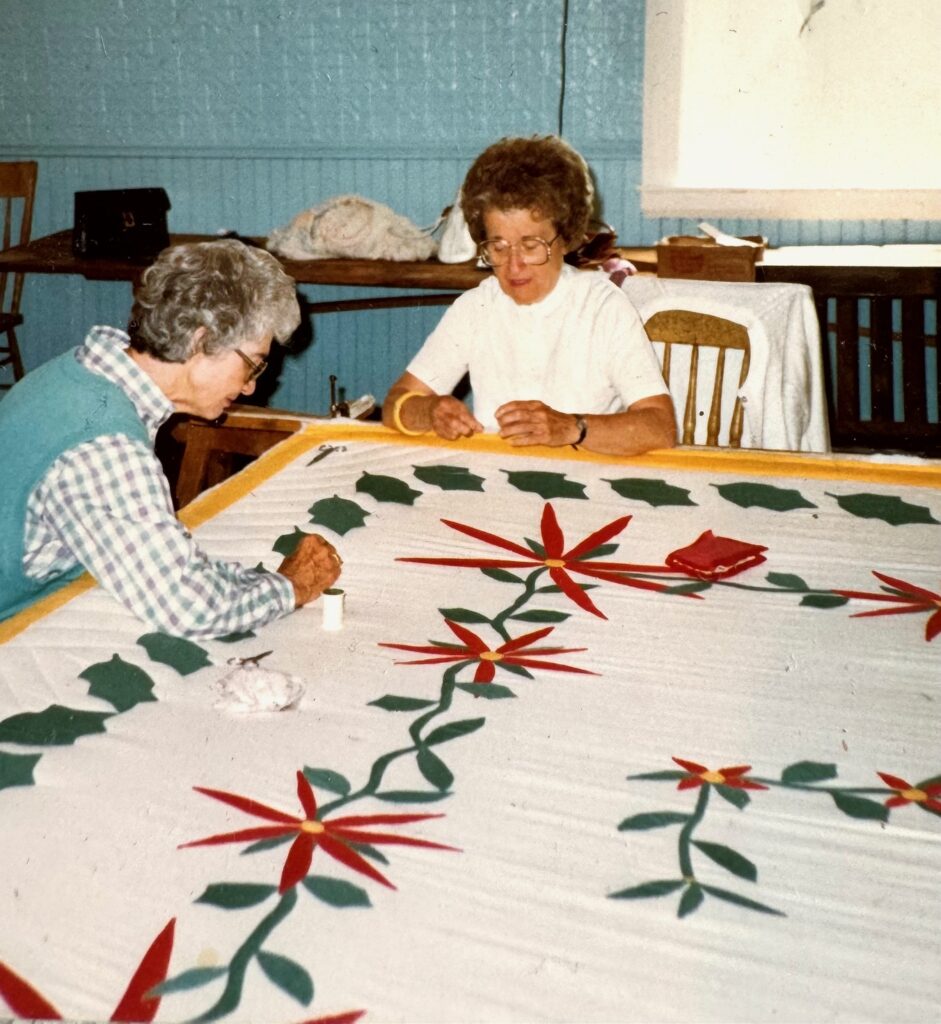
In all of us there is a hunger, marrow-deep to know our heritage,
Alex Haley, American biographer, screenwriter, and novelist
to know who we are and where we came from.
According to Wikipedia, “Heritage is a person’s unique, inherited sense of family identity: the values, traditions, culture, and artifacts handed down by previous generations. Something transmitted by or acquired from a predecessor: legacy, inheritance.”
From both my paternal and maternal ancestors, I come from hardworking people who worked the land and valued natural resources. In this blog, however, I’d like to focus on my mother’s family. Hazel Hall Welch was born and grew up in Whiting, Maine, which was settled in 1785, along the northern coast of Maine. The town’s website states, “Whiting, Maine, a small town with big community spirit.” It is this aspect I’d like to highlight.

My mother, Hazel Hall Welch (right) and friend Vi Crosby (left), stitching a poinsettia pattern quilt, summer 1987.
My mother, grandmother, Olive Hall, great aunt, Genevieve Dinsmore, and cousins Lucy Hall and Gladys Hall Forslund were all members of the “Quilting Bees of Whiting.” This group is still more than 100 years later, actively creating quilts for personal use and to give to those in need. Their community spirit is a significant part of my heritage, and very precious to me. I mentioned in my last blog the new crafting group I and my friend Carole are forming, Krafting Konnections. I hope this group will provide a creative and social outlet; that we can come together to express our creativity and to send positivity out into the world. I am also a member of the “Connect-the-Dots” group. Through both of these organizations, I will continue to contribute to the less fortunate, those who are suffering, and carry on my heritage of community-mindedness.
Though I have made several quilts, my primary craft is crochet. But to honor my mom, our Family and friends, I’d like to share some interesting facts about and history of quilting.
Quilting is the sewing together of layers of fabric; a backing material, padding, and the top, usually decorative layer. Originally sewn and decorated by hand, today, quilting and embroidery machines are options to enable much quicker creation of quilts. Quilt making may date back as far as 3400 BCE, (Wikipedia) when they were used in ancient Egypt to wrap bodies for burial.
The oldest quilt remnants are two sections of a quilt depicting the story of Tristan and Isolde, which date to about 1360. They are preserved and housed in the Victoria and Albert Museum, London, and in the Bargello Palace, Florence.
In Colonial America, scraps left from dressmaking and other sewing projects were used in quilt making. These were used primarily for the practical purposes of warmth and protection. (Garments similar to doublets were worn under armour by knights.) The Industrial Revolution (late 1700s-1830s) made it possible for many households to afford cotton material, thus freeing women from the tedious labor of weaving, and giving them more time for quilt making and other activities. The first widely used sewing machine, created by French inventor Barthelemy Thimonnier in 1829, greatly improved the ease of all sewing projects. The Singer Company started an installment plan in 1856, thus enabling more families to purchase the machines.
Quilting patterns are abundant – geometrics, medallions, free-form, story quilts. Crafters draw inspiration from nature, life imagery, interaction of colors and fabric patterns. But one of the most unusual is the “Crazy Quilt”. In the late 1800’s, “crazies” became very popular. They were usually made to be used as throws rather than as bed-coverings, and were often made using rich fabrics such as velvet, brocade, and silk. Intricate decorative embroidery stitches embellished the seams and centers of the individual pieces. These elaborate creations showcased the talents of the crafter, and became icons of the Victorian era. (AllPeopleQuilt.com)

(photo via @mountainbottomquilts)
Next week I’ll have more about the Quilting Bees and what they’re currently buzzing about.
Stay tuned…
